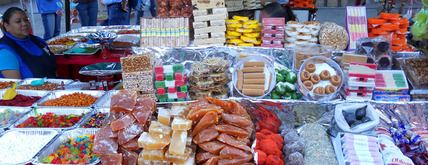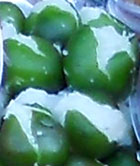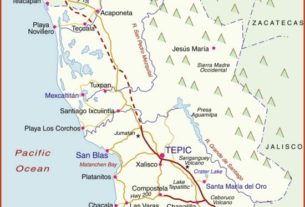Mexican Kitchen
Mention “February”, and one of the first associations that comes to mind is Valentine’s Day. In Mexico, this is not only the saint’s day to be celebrated by boys and girls named Valentín or Valentina, but also called El Día de Amor y Amistad — The Day of Love and Friendship. This leaves out virtually no one, and calls for the same small gifts which are popular north of the border: sweets. Mexico’s vast array of dulcerías (candy stores) panaderías (bakeries) pastelerías and bizcocherías (shops that feature displays of enormous, intricately decorated cakes for special occasions) all give testimony to the national sweet tooth. I have been in pueblos so small that there is only one phone in town, but there always seems to be a dulcería with a great variety of candies stacked to the ceiling, and I always wonder whether so many sweets could possibly be consumed in one small village.

When I taught at the state university in Puebla, my students invariably brought me sweets for special occasions — candied fruit and chocolates for Valentines Day, and a big cake for all to share on El Dá del Maestro — Teachers’ Day. I have coaxed a few recipes from students and friends which are fun to make and give, and would also go well as after-dinner treats.
Dulce de Limon — Candied Limes with Coconut Filling

Particularly attractive are the very old, ornate sweet shops found in Mexico’s colonial cities. Often adorned with Talavera tile and lovely hand-painted designs on walls and ceilings, their window displays are artfully arranged and always tempting. Some of the most attractive elements of these displays are the many kinds of candied fruits, shining like colored glass ornaments. This recipe is easy to prepare, especially for such a visually appealing confection. To give these sweets as a gift, tuck a few of them in a small basket lined with a napkin or doily. Or pass them on a tray or candy dish after dinner.
Ingredients
- 12 limes, very lightly grated (just barely this releases oils from the rind cells)
- Cold water to cover
- 1 1/2 cups water
- 1 1/2 cups sugar
- 1 or 2 drops green food coloring (optional)
Cut the limes crosswise at the stem end and scoop out the pulp. Place them in a heavy pan with cold water to cover, and bring it slowly to the boiling point. Simmer for 20 minutes, drain, and repeat the process four more times.
Combine the 1 1/2 cups of water and the sugar in a saucepan, bring the mixture to a slow boil, cover and cook for 30 minutes, forming a thick syrup. At this point, you can add a drop or two of the food coloring, since some of the fruit’s color is lost in boiling. Add the limes and continue boiling until all syrup is absorbed. Remove the limes from the saucepan and put them on a rack to dry.
For the coconut filling:
Ingredients
- 1 1/2 cups water
- 1 1/2 cups sugar
- Pinch of salt
- 1 cup shredded coconut (canned moist coconut is fine)
- 2 tablespoons butter
Mix the water, suger and salt in a saucepan, and stir over medium heat until the sugar is dissolved. Bring the mixture to a boil and cook it, covered, over medium heat until the steam has washed down any sugar crystals that may have formed on the sides of the pan.
Uncover and cook it to the soft-ball stage (234 degrees on a candy thermometer, or when a small quantity of the syrup, dropped into cold water, forms a ball which does not disintegrate.) Remove the syrup from the heat and stir in the coconut and the butter. When cool fill the limes with the mixture and place them on trays for the centers to dry.
Figuritas de Almendra — Almond Paste Hearts
Almond paste candies are very popular in Mexico, especially in the Puebla region, where they are sold at fairs and on holidays by vendors who walk around with huge trays full of them, most often shaped like chickens. Why chickens? I’ve asked and received the reply that it’s just traditional. I’d like to persue that further, just for fun, but meanwhile, heart shapes are probably more appropriate for Valentine treats.
Ingredients
- 10 ounces blanched almonds
- 10 ounces confectioners’ sugar
- 1 egg white
- 1 teaspoon almond extract
- Food coloring (optional)
Mix the almond paste and the powdered sugar thoroughly, and put them in a blender or food processor with the egg white and the almond extract.
Blend or process until a paste is formed. If it seems too thin to handle, add a bit more confectioners’ sugar; if too thick, add a few drops of lemon juice.
Knead the paste for a few minutes and mold it into any desired shape — hearts, fruit, etc. You can color the figuritas with a little diluted food coloring, using a pastry brush, or you can coat them with powdered sugar. If they are to be given as gifts, wrap each one individually in foil.
Yemita — Fiesta Sweets
Also known as huevitos (“little eggs”), yemitas (“little yolks”) are a specialty of Guanajuato, a region known for its sweets, especially the delicious caramel-type syrup called cajeta. Yemitas are always wrapped in tissue paper (usually blue and white, the colors of the Virgin, Mexico’s patron) and given as “party favors” at fiestas, especially at baptisms and first communions. Wrapped in red and white, they would make attractive gifts for your friends and sweeties. This recipe makes about thirty candies.
Ingredients
- 1/2 cup sugar
- 1 cup water
- 1 dozen egg yolks
- 1 ounce sweet sherry
- Cinnamon-sugar mixture for coating
- Colored tissue squares (about 5″x 5″) for wrapping
Combine the sugar and water in a saucepan, slowly bring to a boil, stirring constantly. When the mixture comes to a boil, cover it and cook it over medium heat until the resulting syrup reaches the hard-ball stage (250º on a candy thermometer, or when a small amount of it, dropped into cold water, forms a ball that is rigid but still pliable.)
Beat the egg yolks very well, and continue beating, preferrably with a paddle-type wooden spoon, until all of the syrup is incorporated.
Put the syrup-egg yolk mixture to cook over a low flame, stirring with the wooden spoon until it thickens and you can see the bottom of the pan when the mixture is separated with the spoon. Remove from flame, add the sherry, and allow the mixture to cool. Working on a cool, smooth surface, “knead” it a bit with a spatula until it has the thickness and texture of fudge. Shape it into balls the size of jumbo olives and roll them in the cinnamon-sugar mixture. Allow them to harden, then place each piece of candy in the center of a square of tissue paper and twist the ends closed. In Mexico, the ends of the tissue paper are usually fringed with scissors, giving the wrapping a festive look indeed.

